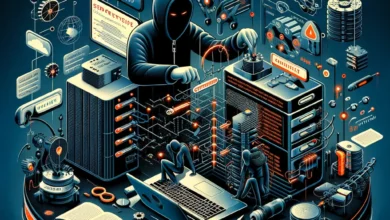Cracking the Code: Navigating Insecure Deserialization Dangers
Unlocking the Secrets of Insecure Deserialization: From Risks to Countermeasures

Dive into the world of cybersecurity, and you’ll soon stumble upon the intricate puzzle of Insecure Deserialization. It’s a term that might sound tech-heavy, but its implications resonate throughout the realm of web applications. Especially for millennials and the digital natives of Generation Z who’ve grown up in a world dominated by the internet, understanding these vulnerabilities is not just a niche tech skill—it’s a language of the modern digital era.
Insecure Deserialization Decoded
In a nutshell, insecure deserialization is what happens when untrusted data is decoded—or deserialized—without the right safety checks. This misstep can pave the way for malicious code execution or unauthorized prying eyes accessing data they shouldn’t.
So, why should the Snapchat and TikTok generation care? Because every app they use, every online transaction they make, hinges on secure data exchange. In a world that celebrates sharing, it’s essential to understand what’s at risk when things aren’t shared securely.
Your Guide to Exploitation Techniques:
Before you can defend against a trick, you’ve got to understand the magician’s secrets. Here are the top exploitation techniques cyber adversaries employ:
- Object Injection: Think of it as introducing a foreign element into a mix. Cyber attackers twist serialized data to sneak malicious objects into an app’s ecosystem. The fallout? Potentially remote code execution or unauthorized tweaks to sensitive data.
- Data Tampering: Here, attackers play puppeteer—manipulating serialized data to influence app behaviors, like tricking an app into thinking they have VIP access when they certainly don’t.
- Denial of Service (DoS): Picture sending a thousand letters to a friend’s mailbox, causing it to overflow. Similarly, by sending peculiar serialized data, attackers can overload an application, causing malfunctions or total breakdowns.
- Remote Command Execution: In some cases, insecure deserialization can be the golden ticket for attackers to commandeer a target server remotely. Imagine someone controlling your computer from miles away; it’s that dangerous.
- Data Leakage: Last but certainly not least, insecure deserialization might inadvertently spill the beans, revealing sensitive data like login credentials.
Shield Up: Counteracting the Threat:
Awareness is only half the battle. Let’s arm ourselves with strategies to defend against these vulnerabilities:
- Input Validation: Picture a bouncer at a club’s entrance. This is essentially checking and cleaning up serialized data before allowing it inside the deserialization party.
- Secure Libraries: Opt for the A-list, top-notch deserialization libraries that abide by strict rules and have built-in defense systems.
- Integrity Checks: Just like verifying a friend’s story to ensure it’s not made up, checking the authenticity of serialized data via signatures or checksums is crucial.
- Principle of Least Privilege: In layman’s terms, it’s giving only the essential access permissions—nothing more, nothing less.
- Stay Updated: Remember to keep up with the latest security patches and updates. It’s like updating your wardrobe; old, outdated stuff won’t protect you against the modern world’s challenges.
Case Studies: When Insecure Deserialization Takes Center Stage
Case Study 1: The Popular Social Media Breach:
A couple of years back, a leading social media platform was hit by a vulnerability in its PHP-based system. A bug in the PHP deserialization process was exploited, leading to the unauthorized execution of codes. This allowed hackers to gain access to millions of user accounts, including their personal messages, photos, and other confidential data. For a generation where social media is not just a platform but a personal diary, such breaches are not just security issues but deeply personal attacks. The breach emphasized the urgency of addressing deserialization issues in popular applications that affect young and older users alike.
Case Study 2: The E-commerce Catastrophe:
An emerging online retail platform catering primarily to Gen-Z and millennials, with its trend-based clothing and accessories, faced a serious backlash when insecure deserialization led to credit card information leakage. By manipulating serialized Java objects, attackers were able to modify price values, granting themselves hefty discounts and even siphoning off customer credit card details. The implications? Massive financial losses and a tarnished reputation, especially among a demographic that highly values trust and digital reliability.
Case Study 3: The Streaming Service Shutdown:
Remember when everyone was hyped about that new binge-worthy series? Well, subscribers of a renowned streaming service had to wait longer than expected when a DoS attack, stemming from insecure deserialization, crashed the service for hours. Crafty attackers sent specially designed serialized data packets, which, when deserialized, consumed excessive system resources. Millennials, being the primary subscribers, took to Twitter to vent, illustrating how such vulnerabilities could lead to PR nightmares and user trust erosion.
Case Study 4: Gaming Platform Gone Rogue:
Gaming isn’t just a pastime anymore; it’s a lifestyle and a profession for many. A much-loved multiplayer game experienced severe lags and unauthorized avatar modifications when insecure deserialization vulnerabilities were exploited. Serialized data was manipulated to grant premium in-game resources for free. This not only impacted the company’s revenue but disillusioned a large base of its users, showing that even virtual worlds aren’t safe from such threats.
Why Real-World Examples Matter:
These case studies aren’t just tales of caution; they are a testament to the interconnectedness of our digital age. When a platform is compromised, it doesn’t just affect faceless users in the ether, but real individuals, many of whom belong to the younger generations who’ve placed their trust in these platforms. It emphasizes that security isn’t just the responsibility of faceless corporations but a collective responsibility.
Drawing Parallels: Why the Digital Age Needs to Wake Up:
Drawing a parallel, imagine giving someone unrestricted access to your diary, bank account, and personal memories. Frightening, isn’t it? That’s what insecure deserialization feels like in the digital sphere. For the Instagram-loving, e-commerce-shopping, binge-watching millennials, and Gen Z, understanding the underpinnings of these vulnerabilities isn’t just optional; it’s crucial.
Wrapping It Up:
In the vast, complex world of cybersecurity, insecure deserialization stands out not just because of its technical aspects but due to its real-world implications, especially for younger generations. These aren’t just tech issues; they are narratives that define how safe our memories, finances, and personal data are in the digital age. Knowledge, awareness, and a proactive stance on such issues will define how resilient our digital future will be. So, the next time you swipe on an app or click on a website, remember the silent machinery working behind the scenes and the potential vulnerabilities that could exist. It’s a reminder that in our ever-connected world, being aware and informed is our most potent defense.




